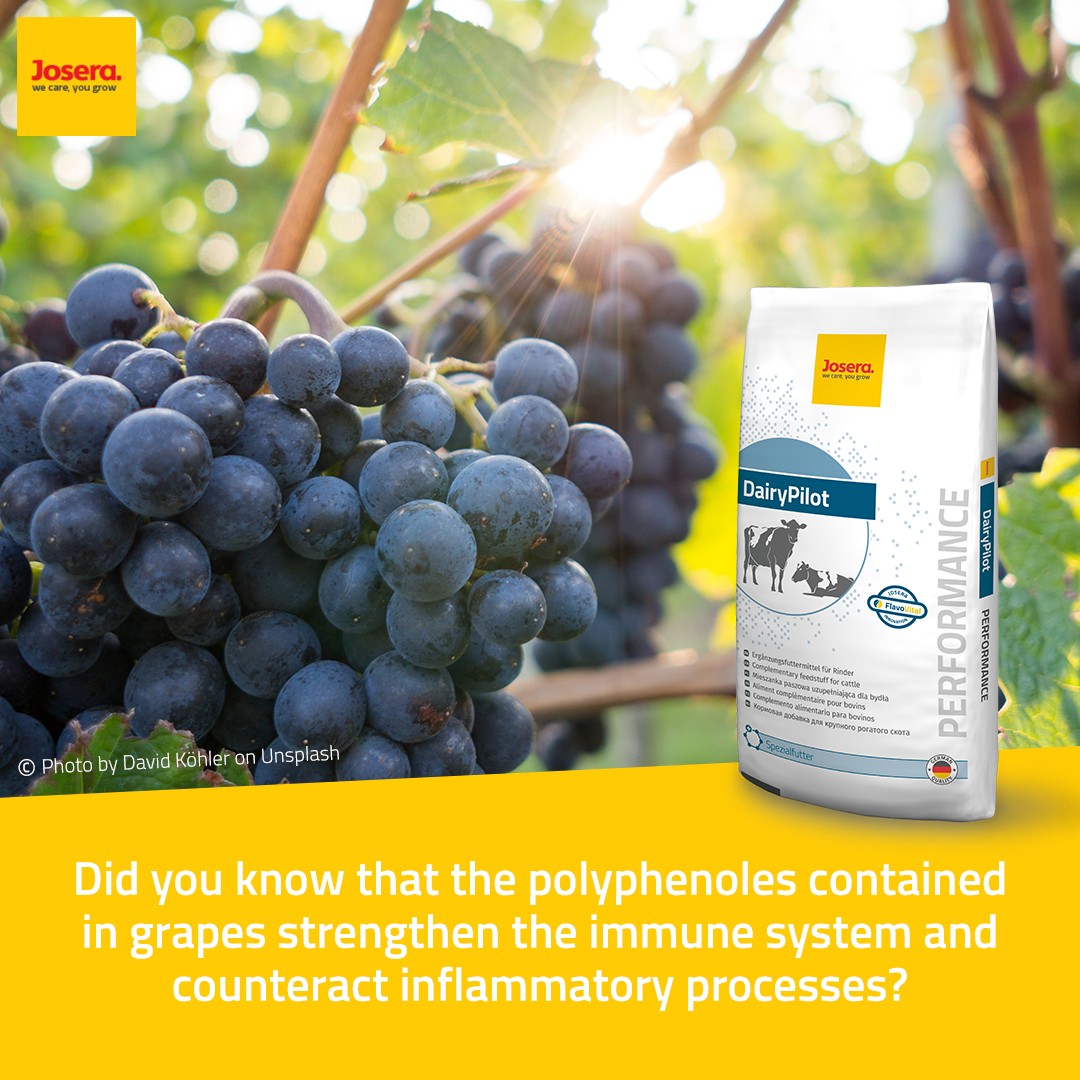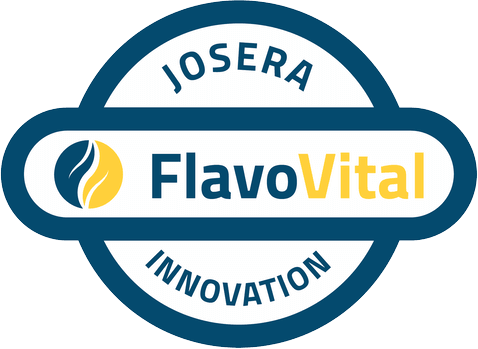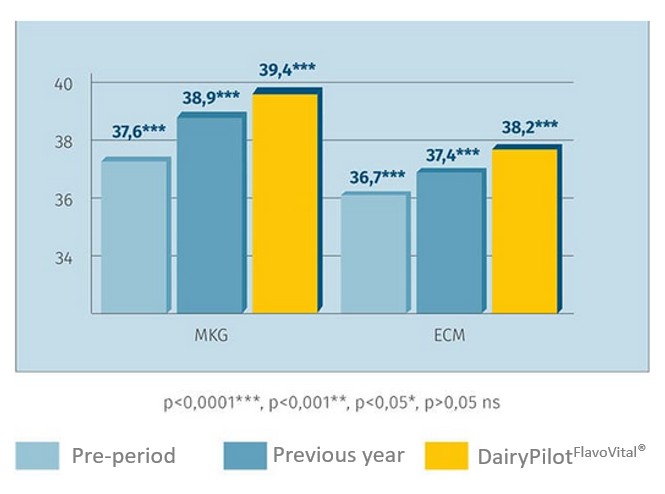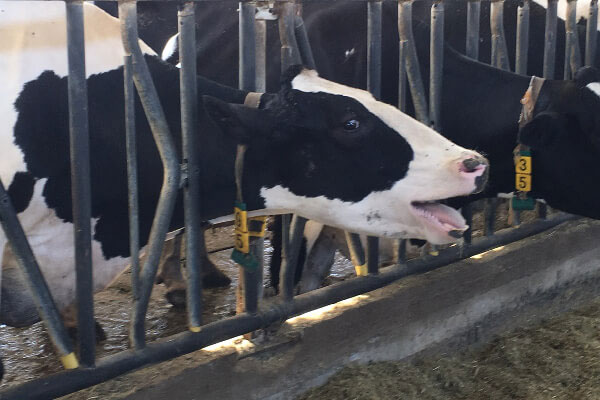Table of Contents
- What is DairyPilotFlavoVital®?
- How does DairyPilotFlavoVital®differ from other products?
- When do I use DairyPilotFlavoVital®?
- What advantages do I have as a farmer by using DairyPilotFlavoVital®?
- What are the advantages of DairyPilotFlavoVital® for my herd?
- What is DairyPilot green?
- How can the rumen pH value be stabilised even with high amounts of concentrated feed?
- How can the energy deficit be reduced more quickly with DairyPilotFlavoVital®?
- How does feeding DairyPilotFlavoVital®contribute to improving insemination success?
- How can feeding improve lactation persistency?
- Does DairyPilotFlavoVital®also help with ketosis problems?
- To what extent does feeding contribute to improved udder health?
- What influence does DairyPilotFlavoVital®have on colostrum quality?
- How is DairyPilotFlavoVital®fed?
- What experiences have farmers had with DairyPilotFlavoVital®?
- How does DairyPilotFlavoVital®contribute to better animal health?
- How can cell stress be reduced to strengthen the immune system?
- Scientific explanations
- What trials are there on DairyPilotFlavoVital®?
- Areas of application for DairyPilotFlavoVital® ?
What is DairyPilotFlavoVital®?
DairyPilotFlavoVital® is:
- a tasty supplementary feed for dairy cows with polyphenol-containing components of selected fruits and herbs, called FlavoVital, with B vitamins and live yeast.
- an important aid to keep high performance and animal health in balance.
- responsible for a healthy rumen, as well as high metabolic efficiency.
- recommended in every herd and ration, both from an economic point of view and for animal welfare reasons.
How does DairyPilotFlavoVital® differ from other products?
DairyPilot contains …
- FlavoVital®
These are cell-protecting plant ingredients from selected fruits and herbs, processed in a unique package of active ingredients to: -
- Strengthen the defences against inflammatory processes and oxidative stress
- Stabilise and relieve the metabolism
- Increase metabolic efficiency
- Reduction of cell stress
- B vitamins
These support the rumen microbes and thus the metabolism of the animals (exception: B vitamins are not contained in DairyPilot green, JOSERA DairyPilot green can be used in organic farming) - Live yeast
This stabilises the rumen environment. This allows the microbes to work better and increases feed conversion.
When do I use DairyPilotFlavoVital®?
- General areas of application:
- For birth preparation
- During lactation
- For rearing calves
- In bull fattening
- For concentrated feed rations
- To improve feed conversion
- To ensure high performance
- For digestive and metabolic disorders
- In stress situations (e.g. heat, transit phase, etc.)
DairyPilot green is a product variant that can be used specifically for organic farming.

How can the rumen pH value be stabilised even with high amounts of concentrated feed?
Live yeasts, as also contained in JOSERA DairyPilot, are metabolically active yeasts specially bred for animal nutrition. They belong to the group of feed additives. The probiotic effect of the live yeast in DairyPilot promotes digestion, minimises unwanted microorganisms and stabilises the rumen and intestinal environment. Feeding live yeast to cattle has been shown to have a positive effect on the animals’ rumen metabolism – this is also the case when feeding DairyPilot.
The live yeast cultures in DairyPilot also consume residual oxygen, which keeps the concentration of lactic acids low and increases the pH value in the rumen. This stabilises the rumen balance and reduces the risk of rumen acidosis.
Other positive effects of DairyPilot live yeasts on rumen metabolism are improved feed conversion, higher feed intake and an increasing flow of duodenal protein. These effects imply healthier and better performing animals in the long term.
How can the energy deficit be reduced more quickly with DairyPilotFlavoVital®?
Feeding dry cows, transit cows and freshly lactating cows is a particular challenge. It is essential to divide the feeding into these three phases in order to cover the animals’ needs as precisely as possible.
As the cow is exposed to particular stress factors during these phases, it is also necessary to minimise all forms of stress in addition to feeding. The Fresh Cow, for example, is exposed to particularly strong stress during this period: The cow has to recover from the exhausting calving and rejoin the herd, while regression and an enormous metabolic changeover take place and the fresh cow has to enter lactation with adequate performance.
All these factors put both mental and physical stress on the animals. This stress and possible inflammations have to be combated inside the cow’s body in an energy-intensive way. During this time, the cow consumes more energy than it can absorb. As a consequence, it is in an energy deficit – the cow lacks energy for crucial metabolic processes. However, the fewer stress factors the cow is exposed to and the higher her feed intake, the lower the energy deficit. This improves the cow’s health, strengthens the immune system and creates high life efficiency and a long useful life. In addition, the cow gets pregnant again more quickly. In addition to optimised husbandry conditions and management, JOSERA DairyPilot is very suitable here for increasing the metabolic efficiency in the animal and thus achieving more performance.
How does feeding DairyPilotFlavoVital® contribute to improving insemination success?
A major factor influencing the fertility of a cow is feeding. Especially the supply of energy and protein is essential at the beginning of pregnancy. If there is a deficiency here, in many cases the embryo will not implant and resorption of the fertilised embryo will be the result. Feeding according to requirements is essential in this phase. Avoid any deficiency!
A high feed intake improves the cow’s need-based supply. Regularly pushing the feed is an inexpensive and simple solution to increase feed intake. In addition, the use of live yeast is recommended during the dry period and lactation. With the high proportion of live yeasts, rumen-stimulating herbs and metabolism-supporting B vitamins, JOSERA DairyPilot provides your cows with the highest level of nutrition during this period: DairyPilot supports raw fibre digestion and consumes acids, so that feed intake increases and better utilisation of the valuable basic feed is achieved. This supports the needs-based supply of dry cows and lactating cows.
How can feeding improve lactation persistency?
What is lactation persistency?
Lactation persistency is a measure of the course of the lactation curve and describes the persistence of a lactation state. Lactation persistence indicates how fast the daily milk quantity decreases during lactation. Cows reach their peak performance, approximately 40 to 43 kg of milk, 50 to 60 days after calving, with young cows this value is reached at 80 to 100 days. Peak performance depends on rearing, animal health, genetics, forage quality and feeding both before and after calving.
Economic impact for your farm
Persistency has an economic impact on your farm: cows with poor persistency not only lead to lower milk yield, they also cause high feed costs. This is because cows with poor persistency need expensive concentrate and other supplementary feeds in the start-up phase to ward off metabolic disease. At the end of lactation, this in turn often results in the animals becoming fatty.
Achieving good persistency through feeding
Feeding that is appropriate for ruminants and their needs, as well as adapted to the current lactation status, is the basis of animal health and thus also animal welfare. Therefore, ensure a high and high-quality basic feed intake for your cows. Also support the rumen microbes of your animals. The use of JOSERA DairyPilot helps here, creating optimal development of the microbiome in the rumen.
Does DairyPilotFlavoVital® also help with ketosis problems?
Yes, JOSERA DairyPilot supports the prevention of ketosis.
The transit phase and usually also large parts of lactation remain a challenge for animal nutrition. Again and again, the balancing act between a negative energy balance and a sufficient supply of structural feed has to be mastered.
Due to a reduced feed intake shortly before and after birth, this is particularly difficult. At least subclinical ketosis are therefore the order of the day on many farms. DairyPilot stabilises the metabolism, increases metabolic efficiency and can thus reduce the frequency of ketosis.
You have ketosis problems and don’t know what to do? Contact us now.
To what extent does feeding contribute to improved udder health?
In order to achieve economically successful milk production, healthy udder tissues are essential. This is because a large number of mastitis cases and high cell contents lead to large quantities of unsaleable milk, rising treatment costs, increased time expenditure and ultimately to an abortion rate of 15% – 20%.
Mastitis is a factor disease. In addition to genetic prerequisites, milking work and husbandry hygiene, metabolism and thus feeding play a central role in relation to mastitis. All stress factors, such as overcrowding or stable climate, also have an effect on the metabolism via stress hormones and their effect. Since the metabolism is under great strain, especially at the beginning of lactation, this is where problems most often occur.
Particularly at the beginning of lactation, problems often occur due to the heavy strain on the metabolism, so that special attention must be paid to dry stall and feeding management. With JOSERA DairyPilot, this stress phase in particular can be significantly alleviated through its stabilising function on the rumen flora.
With the use of DairyPilot and the implementation of several other measures to improve the quality of the basic feed, the udder problems on the Kreuzer Farm have improved noticeably. This goes hand in hand with improved feed conversion. Learn more here.
What influence does DairyPilotFlavoVital® have on colostrum quality?
A calf is born without energy reserves and with a deficient immune system into an outside world colonised by germs. Since it has not yet received maternal protection from its mother, the calf must now gain this protection by ingesting fresh colostrum. It is important that the calf consumes at least two litres of colostrum within the first four hours after birth in order to absorb antibodies from the mother’s milk in the intestine and establish passive immunisation. If a calf does not absorb antibodies, it is defenceless against pathogens and infections. On the first day after birth, the calf should consume at least four litres of colostrum in total. It is important to check the quality of the colostrum.
The knowledge that the level of immunoglobulins in the colostrum has an influence on the immunity of the calf and thus on its future development is not new. The quality of the colostrum can be determined with a colostrum spindle or a refractometer. With the refractometer, the immunoglobulin content is expressed by the so-called Brix value.
In a trial on two dairy farms, the influence of 100 g JOSERA DairyPilot in the preparatory feed on the Brix value was analysed. Of a total of 72 calvings, 33 were in the DairyPilot trial groups and 39 in the control groups. The Brix values were measured at the first milking using a refractometer, and the following picture emerged:
A Brix value > 22 or higher indicates good colostrum quality. This was the case in both the control (K) and the experimental group (V). Nevertheless, the experimental group showed a significant increase of the Brix value by 2.4 points, which speaks for a better colostrum quality.
By using DairyPilot, an improvement of the colostrum quality could be observed in the trial. In general, the better the colostrum quality, the better the protection of the newborn calf and thus better conditions for its further development.

How is DairyPilotFlavoVital® fed?
It is used throughout lactation at 100 – 150 g per animal and day and at 100 g in preparation for birth.
In cases of high stress, such as acidosis, ketosis, metabolic stress, digestive disorders, claw and udder problems, we recommend up to 200 g per animal and day.
The recommended use for rearing calves and bulls varies.
What experiences have farmers had with DairyPilotFlavoVital®?
Many farmers have already successfully used JOSERA DairyPilot. You can find testimonials here.
According to Mrs. Engel, since the use of DairyPilot, a certain calmness and continuity has been noticed in the herd.
Martin BABE noticed already in the first months after feeding DairyPilot a better atmosphere within the herd.
Less heat stress, fedd intake and a higher milk production during summer compared to last year.
Magdalena Rzepka from Poland was able to significantly improve feed conversion by using JOSERA DairyPilot.
How does DairyPilotFlavoVital® contribute to better animal health?
On the one hand, the aspect of animal health is of particular importance in times of volatile markets and a critical examination of animal husbandry by the public. On the other hand, a healthy cow is essential for economically successful milk production, and not only since the latest reports. Thus, large parts of the lactation period remain a challenge for animal nutrition.
Again and again, the balancing act between a negative energy balance and a sufficient supply of structural feed must be mastered. But also unfavourable circumstances such as heat stress, group changes, ration changes, insufficient feed quality, etc. can lead to performance losses and negative consequences with reduced life efficiency. In addition to the factors mentioned, there are a number of other influencing variables that have an impact on animal health and performance. These range from germs to housing-related causes that can cause technopathies such as lesions. In addition, larger herds often make it more difficult to feed or care for individual animals.
JOSERA DairyPilot helps the farmer to face exactly these tasks: DairyPilotFlavoVital® supports the farmer in having an inconspicuous and reliably performing cow with a long service life throughout the entire lactation in order to achieve a high life efficiency of the herd. After all, healthy cows mean increased animal welfare and thus less work and emotional relief for the farmer.
How can cell stress be reduced to strengthen the immune system?
Unavoidable conflicts in feeding and in ration and herd management, stress caused by germs, hygiene deficiencies in the barn and during calving, suboptimal housing conditions, as well as mechanical stress caused by the daily milking process are latent stress factors for animal health and are the cause of inflammatory foci. The cow’s immune system is permanently on alert and becomes active with every disturbance – regardless of whether it is an actual inflammation or not.
For example, if the cow’s body receives a bump, this is a disturbance. The immune system becomes active at the bumped site to respont to inflammation if necessary. If there is no inflammation, the immune system withdraws from the affected area. The consequence is an unnecessary loss of energy for the cow. This is because a lot of energy is lost due to the large number of small, irrelevant disorders for which it would not be necessary to trigger the complete cascade. This not only harms performance, but also makes it more difficult to defend against an actual inflammation.
In the case of an actual inflammation in a disruptor, the immune system – in contrast to disruptors without inflammation – remains active at the bumped site to heal the inflammation. This requires production of additional blood cells – energy is expended.
The constant inflammatory processes in the cow’s body, which are energy-consuming regardless of their relevance, the so-called background noise, are omnipresent in the animal. The background noise runs subliminally in the background and thus negatively influences the performance or impairs the health of the animals.
Disease patterns for inflammatory processes
- Mastitis (inflammation of the udder)
- Uteritis
- Inflammation of the hooves
- Lesions of the skin, phlegmon
- Acidosis (inflammation of the rumen and intestinal mucosa)
- Diarrhoea
Video: The so-called “background noise” in the animal can be imagined like an internal storm.
Inflammatory processes and subliminal background noise hinder performance
- The body fights false alarms and interference fires and is on heightened alert
- This process consumes energy
- The animals feel ill
- Appetite decreases
- Performance decreases
Figure 1: Background noise is omnipresent and influences performance and well-being.

Inflammation is the body’s response to damage. This can be of different nature
- Physical (injury, foreign body, radiation, heat, cold)
- Chemical (acids, alkalis, toxins)
- Biological (viruses, bacteria, fungi)
The aim of inflammation is to eliminate the harmful stimulus, prevent the damage from spreading and restore the tissue’s ability to function.
Video: The “background noise” is reduced in the body and the animal can concentrate on the essential processes again.
Although the background noise cannot be prevented, it can be reduced: JOSERA DairyPilot strengthens the defences in inflammatory processes and reduces oxidative stress. This is because FlavoVital has a calming effect on NF-κB, the key regulator of inflammatory processes. As a result, the immune system only becomes active when stronger triggers occur and minimises energy losses due to unnecessary immune reactions of the body to low-level stimuli. As a result, the background noise in the cow’s body is reduced and the animal’s immune system is no longer “permanently active”. The energy saved by this can now be channelled into real inflammatory processes and thus protects the cow from infections.
The energy resources gained are also made available for postpartum recovery or milk production. This is because the saved energy creates better conditions for the start of lactation and makes the cow more efficient.
Scientific explanations
Recent scientific studies have shown that and how nutritional factors contribute to the expression of genes (nutrigenomics). The best-known example in animal nutrition is metabolic programming in calves. In this case, optimal feeding in the first three weeks of life has a lasting advantage on later performance.
Secondary plant compounds (polyphenols) have a similar effect on gene expression, as they influence inflammation and cell stress and thus save resources. This is particularly important in the case of a negative energy balance and in extreme situations (birth, heat, high performance, group change, high pathogen pressure, etc.). In contrast to metabolic programming, however, this effect is not permanent, but bound to the period of feeding.
A working group led by Prof. Eder (Gessner et al. 2015, submitted) has impressively demonstrated this: The targeted administration of plants containing polyphenols led to a 3.5 kg increase in performance in dairy cows and all genes involved in inflammation were less pronounced. This speaks for a reduced inflammatory process. In addition, a gene indicating a fatty liver was significantly less pronounced.
Polyphenols thus have a positive influence on the performance of dairy cows and at the same time promote animal health (Table 1 and 2). (mod. according to Gessner et al. 2015)

| Calving to 2 weeks postpartum | ||||
|---|---|---|---|---|
| Variable | Unit | Control | P-
group |
p-value |
| DM intake | kg/d | 16.6 | 17.2 | 0.515 |
| Milk yield | kg/d | 35.4 | 39.0 | 0.029 |
| Energy corrected milk yield | kg/d | 33.9 | 37.0 | 0.045 |
| Fat content | % | 4.03 | 3.92 | 0.329 |
| Protein content | % | 3.20 | 3.22 | 0.871 |
| Lactose content | % | 4.80 | 4.83 | 0.470 |
| Fat yield | kg/d | 1.37 | 1.47 | 0.142 |
| Protein yield | kg/d | 1.09 | 1.21 | 0.028 |
Table 1: The influence of polyphenol containing parts of plants on the performance of dairy cows
| Control | Polyphenol group* | |
|---|---|---|
| CRP | 1 | 0.77 |
| HP | 1 | 0.46 |
| TNF | 1 | 0.69 |
| ATF3 | 1 | 0.77 |
| UGT1A1 | 1 | 0.52 |
| FGF21 | 1 | 0.38 |
| *Polyphenol value relative to control group | ||
Table 2: The influence of polyphenol containing parts of plants on inflammation and cell stress genes.
What trials are there on DairyPilotFlavoVital®?
In several years of development work, JOSERA has developed a unique herbal active agent package. This is called FlavoVital, and specifically uses the synergy of selected polyphenol-containing fruits and herbs. FlavoVital was intensively tested in a large-scale field trial with over 6,000 cows in different countries (see Table 3). All trial farms fed a B-vitamin-containing product (control) both in the previous year and in the previous period. After a six-month trial period with JOSERA DairyPilot, a comparison of the performance data with the previous period and the previous year was made.

Despite the inclusion of Pansen-Pilot in the ration during the control phase, a significant higher performance could be achieved with DairyPilot (see figure 1).
| Minimum |
Maximum | Average | |
|---|---|---|---|
| Milk herd size | 80 | 1,175 | 299 |
| Milk amount, kg/year | 7,485 | 12,888 | 9,551 |
| Fat, % | 3,64 | 4,42 | 4,03 |
| Protein, % | 3,27 | 3,58 | 3,42 |
Table 3: Summary of the experimental farms

Figure 2: Significant higher milk yields with DairyPilotFlavoVital® in comparison to Pansen-Pilot
DairyPilotFlavoVital® also shows its positive influence with regard to cell counts (Table 4) and metabolic disorders (Table 5), which differ significantly.
| General data | Unit |
6/2014 | 5/2015 |
|---|---|---|---|
| Cows in milk | Cow | 199 | 202 |
| Lactation stage | Day | 178 | 176 |
| Daily performance | Kg/cow/day | 42,3 | 43,9 |
| Udder health | Unit | 6/2014 | 5/2015 |
| Somatic cell count | 1,000 cells/ml | 166 | 90 |
| Infected cows | % | 19.6 | 8.9 |
| Infected cows at first check | % | 21.4 | 0 |
| Cows with chronic infection | % | 10.6 | 6.4 |
| Infection rate new lactation | % | 9.4 | 2.7 |
| Infection rate dry period | % | 11.1 | 3.8 |
| Uninfected rate post dry period | % | 77.8 | 100 |
Table 4: Improved udder health was observed in comparison with the previous year (LKV-data, farm Cerini, Latvia)
| Control | DairyPilotFlavoVital® | |
|---|---|---|
| Cows with ketosis (fat / protein ratio > 1.5) |
548 | 447* |
| Total cows | 3,968 | 4,068 |
| *p < 0.05 | ||
Table 5: Impact of DairyPilotFlavoVital® on metabolic disorders1
1 results to 07/2015
The farmers participating in the trial also report a better
- A better constitution of the animals
- Higher stress resistance in extreme situations (heat, suboptimal feed quality, transit phase, etc.)
- Lower veterinary costs.
Due to the high demands on our high-performance cows, influenza illnesses can often lead to high performance losses. Fighting the flu and the cow’s recovery take up a large part of the already scarce energy, which is why the prevention of an influenza illness must be a high goal. For this reason, strengthening the immune system should be a concern of all dairy farmers. In addition to an optimal and stress-free husbandry system, this is exactly where JOSERA DairyPilot can come in with its well-known effect. JOSERA DairyPilot reduces cell stress and thus supports the immune system.
The temperatures in early summer and heat periods show impact on dairy cows. Unlike humas, however, cows would avoid summer. At temperatures above 20°C and high humidity, high performance cows in particular suffer from heat stress. Ketosis and rumen acidosis are frequent consequences here and thus performance, animal health and fertility are also influenced.
Limited basic feed quantities and strongly fluctuating qualities may make it necessary to check the supply of minerals and active ingredients. Maize-based rations, due to a lack of grass silage, have a significantly lower ß-carotene content than grass-based rations. Since an optimal ß-carotene supply is essential for fertility, bottlenecks can occur here especially in times of reduced feed intake (transit phase). Follicles have a memory, which means that fertility problems persist for several weeks after a shortage and the fertilised egg has a lower chance of survival. The same applies to grass silage with a dry matter content of more than 45%. In these cases, a ß-carotene supplement is recommended until the next pregnancy. It is important to optimise the utilisation of nutrients. In addition to an optimised ration, the use of JOSERA DairyPilot is recommended for more efficient nutrient digestion in the rumen.
You might be interested in the following contents:
Udder health – influence with feeding
A question that is often raised is what can I do against mastitis and a high cell count. Here you can learn more about how you can boost the udder health of your animals.
Heat stress in cattle
During the summer, we humans often break into a sweat. But how do our animals manage the heat? Read this article to find out more about heat stress in cattle.







 (2 Votes, average: 3.50 von 5)
(2 Votes, average: 3.50 von 5)
